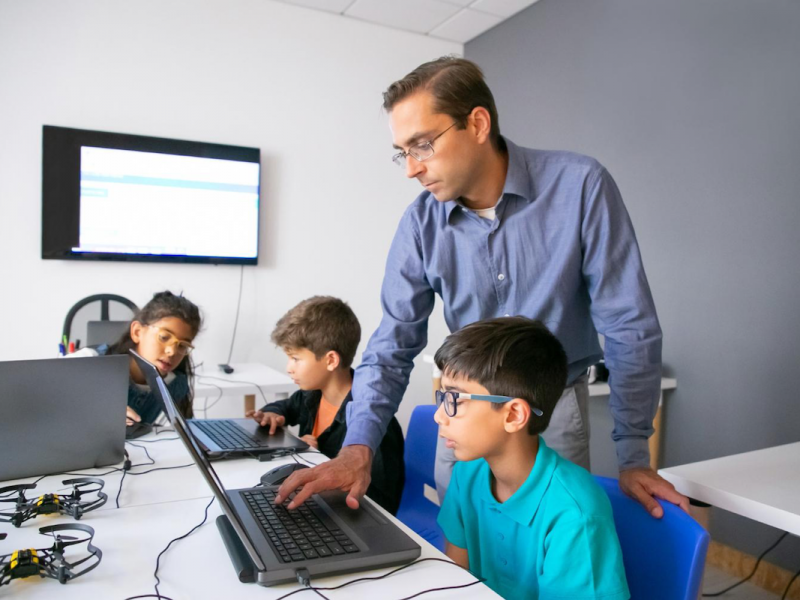The Indian education system has recently realised the significance of technology adoption, in the face of the pandemic. When the lockdown forced the closure of physical classrooms, schools turned to technology enabled solutions for conducting virtual classes, which has helped accelerate the growth of edtech sector manifold, within a short time span. As per an ‘EdTech In India’ report by Omidyar Network India and RedSeer Consulting, the Indian edtech market, which consititutes under 1% of India’s USD 90 billion of India’s private education market, clocked a 120% growth during the covid, and is expected to reach a valuation of USD 1.7 billion, from the USD 735 million, by the end of the calendar year of 2020.
While these are encouraging numbers, the jump has been organic and haphazard, driven mostly by the urgent need for a solution, instead of being a proactive and planned transition. The virtual classrooms, recorded video tutorials and even the online study groups with assisted learning and online examination features, are all well appreciated for now. But once the lockdown ends and schools open, the focus for learning may again shift to the traditional classroom format, just like taking a step back from development.
It’s important then that schools understand the key benefits of adopting technology based learning into mainstream education, as listed below:
Efficient and resource friendly format: Tech-enabled learning tools, including pre-recorded lectures, digital books and virtual classrooms, help save time and prove to be interactive and effective learning tools for children. It also allows teachers to focus on key mentoring and brainstorming aspects of teaching instead of just dispensing information, as was the case in traditional classroom format. Additionally, online assessments backed by data analytics offers valuable measurable insights into student and teacher performance, that can help identify and improve specific areas of concern.
Allows skill development for teachers: Online learning has been as beneficial for teachers as it has been for students. Digital classes and online courses that promote continuous learning, are helping teachers to stay abreast with the latest developments in their field and hone their skills from the comfort of their homes, while keeping their jobs. The on-demand sessions with credible certification help immensely in career development and growth, which earlier demanded a full time attention and effort.
Agile and connected learning: Thanks to edtech firms that provide app based learning, education has become agile and connected! Schools area able to leverage the platform for effective engagement with parents, where they can also take feedback via Surveys in a flash for new initiatives/areas of improvement. Also, the remote learning benefit through recorded videos or online live streaming of classroom can allow for on-demand / anytime learning for students who are unable to attend school or online class due to health or other reasons, eliminating the dependency on handwritten notes.
It is particularly significant now when schools are looking to reopen keeping social distancing norms in mind and may not function at full classroom capacity. This also provides agility for students in case they need to travel or learn from a remote place, allowing parents to plan vacations that no longer revolve around school holidays.
Smarter classroom education: With adoption of smarter technology solutions, modern classroom can add several feature, including a live streaming camera with a good internet connection, which can become a differentiator and allow schools to reach out to students beyond their geographical reach.
These, in addition to smart boards, and technologies such as OCR for scanning notes, AI for evaluating submitted assignments and exams, Facial recognition and eye movement tracking to capture student attendance, interest, and involvement etc., can transform classroom education to a different level of efficiency. Further, with these features, good schools can potentially cater to more number of students (with rotating class/online days) with the same school infrastructure, making smart education available and accessible to many!
Secondary gains: With technology enabled solutions, the overall curriculum can be effectively managed with proper use of time and resources, helping create space for practical learning opportunities, including, workshops, site visits, and internships for higher learning students.
Further, students would be encouraged to learn and leverage some of the smart classroom technologies for their projects, thus enabling them to learn and adopt these technologies first hand, at a young age, helping them evolve. India is a young country with an estimation of a huge population of young, earning population in the next decade, and creating relevant and technology enabled learning solutions will help build cognitive and overall competence among students, required for solving modern problems.
– Ashish Chaturvedi, Founder School Diary®
Technology innovations have disrupted various sectors of business and lifestyle and future jobs are going to be for those who are tech-savvy, making it imperative for children to get acquainted with the latest tools, at an early age.
However, even as we bask in the recent edtech innovations, designed during the pandemic, they would all be redundant if schools fail to wake up to the significance of a more integrated approach to learning.
Adopting these technology enabled solutions as part of mainstream learning and not just as a back-up alternative, is the way forward, if we are to learn anything from the pandemic and help build a smarter education system for a smarter generation of the future.
Authored by Ashish Chaturvedi, Founder School Diary® and first published in “India Today” on Sep 16, 2020


